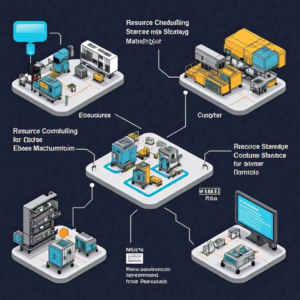Cloud Computing Strategy and Resource Scheduling for Edge Cloud in Smart Manufacturing

Introduction
The rise of Industry 4.0 has revolutionized traditional manufacturing, giving way to smart manufacturing systems that utilize advanced technologies such as edge cloud, the Internet of Things (IoT), and artificial intelligence (AI). One of the key challenges in this transformation is effectively scheduling computational resources, especially in edge cloud environments. A solid cloud computing strategy is essential for addressing these challenges. This blog discusses resource scheduling strategies tailored for edge cloud applications in smart manufacturing, focusing on hybrid computing architecture, algorithms for resource allocation, and their impact on operational efficiency.
1. Cloud Computing Strategy and Hybrid Computing Architecture in Smart Manufacturing
The hybrid computing architecture combines various layers of computing resources, including device computing, edge cloud, and cloud computing, to meet the real-time needs of smart manufacturing. A well-defined cloud computing strategy is vital for overcoming latency issues often found in traditional cloud-centric models. In such models, tasks can be delayed due to the distance between cloud servers and manufacturing devices.
1.1 Components of the Hybrid Architecture
- Device Computing Layer: This layer includes manufacturing devices that generate tasks. While these devices have limited computing power, they play a crucial role in real-time data collection and control.
- Edge Cloud Layer: Located closer to the devices, edge cloud servers (ECS) manage time-sensitive tasks, significantly reducing latency. They process data locally, allowing for immediate responses to operational requirements.
- Cloud Computing Layer: The cloud serves as a centralized resource for extensive data storage and processing. It is used for non-time-critical tasks and complex computations that require significant resources.
- Software-Defined Networking (SDN) Layer: This layer helps coordinate and manage resources across the different computing layers, ensuring efficient data flow and resource allocation.
Integrating these layers creates a more responsive and efficient manufacturing environment. It can adapt to dynamic production needs.
2. Resource Scheduling in Edge Cloud and Cloud Computing Strategy
Effective resource scheduling in edge cloud is essential for optimizing performance. It ensures that manufacturing processes are both efficient and responsive. This section covers the strategies and algorithms used for resource scheduling in edge cloud environments.
2.1 Challenges in Resource Scheduling
The main challenges in resource scheduling for edge cloud in smart manufacturing include:
- Latency Constraints: Tasks must be processed within strict time limits to maintain operational efficiency.
- Resource Heterogeneity: Different edge cloud servers have varying capacities for computing, storage, and task loads.
- Dynamic Task Generation: Manufacturing environments often experience unpredictable task generation, requiring flexible scheduling strategies.
2.2 Scheduling Algorithms
To tackle these challenges, various algorithms have been developed for scheduling tasks in edge cloud environments, guided by a robust cloud computing strategy. Two primary strategies include:
- Selection of Algorithms for Edge Cloud Servers (SAE): This strategy focuses on choosing the most suitable edge cloud server for a task. It considers computing power, current load, and communication time. The algorithm evaluates each edge cloud server’s performance. It assigns tasks to minimize processing time and maximize efficiency.
- Cooperation of Edge Cloud Clusters (CEC): When a single edge cloud server cannot meet the latency requirements for a task, this strategy distributes the task across multiple edge cloud servers. By breaking tasks into subtasks and processing them in parallel, the system achieves lower latency and improved performance.
2.3 Two-Phase Scheduling Algorithm
A two-phase scheduling algorithm combines both SAE and CEC strategies to enhance resource allocation in edge cloud:
- Phase One: The algorithm assesses available edge cloud servers and selects the most appropriate one. It bases this on the task’s requirements and the server’s capabilities.
- Phase Two: If the selected server cannot meet the latency constraints, the algorithm redistributes the task among multiple servers. This ensures overall processing time remains acceptable.
This hybrid approach has shown significant improvements in real-time performance, user satisfaction, and energy consumption.
3. Implications for Smart Manufacturing and Cloud Computing Strategy
Implementing effective resource scheduling strategies in edge cloud has significant implications for smart manufacturing:
3.1 Enhanced Operational Efficiency
By reducing latency and optimizing resource use, manufacturers can achieve greater operational efficiency. Tasks requiring immediate attention can be processed at the edge cloud. This reduces the time required for data transmission and processing.
3.2 Improved Flexibility and Responsiveness
The dynamic nature of manufacturing environments requires flexible resource scheduling. The ability to adapt to changing task demands and resource availability enables manufacturers to respond quickly to market changes and customer needs.
3.3 Energy Efficiency
Optimizing edge cloud resources can lead to substantial energy savings. By processing data locally and minimizing the need for extensive data transmission to the cloud, manufacturers can lower their overall energy consumption.
4. Conclusion
The integration of edge cloud into smart manufacturing presents unique challenges and opportunities, particularly in resource scheduling. By leveraging hybrid computing architectures and advanced scheduling algorithms, manufacturers can enhance operational efficiency, improve responsiveness, and achieve energy savings. A solid cloud computing strategy, combined with innovations like Edge Computing in Manufacturing and Key Technologies, is essential as the industry evolves. The importance of effective resource scheduling strategies will continue to grow, paving the way for more intelligent and adaptive manufacturing systems.
In summary, the resource scheduling strategy for edge cloud in smart manufacturing is a crucial element. It enables organizations to maximize their technological investments, driving innovation and competitiveness in an increasingly complex market landscape.
Do you like to read more educational content? Read our blogs at Cloudastra Technologies or contact us for business enquiry at Cloudastra Contact Us.